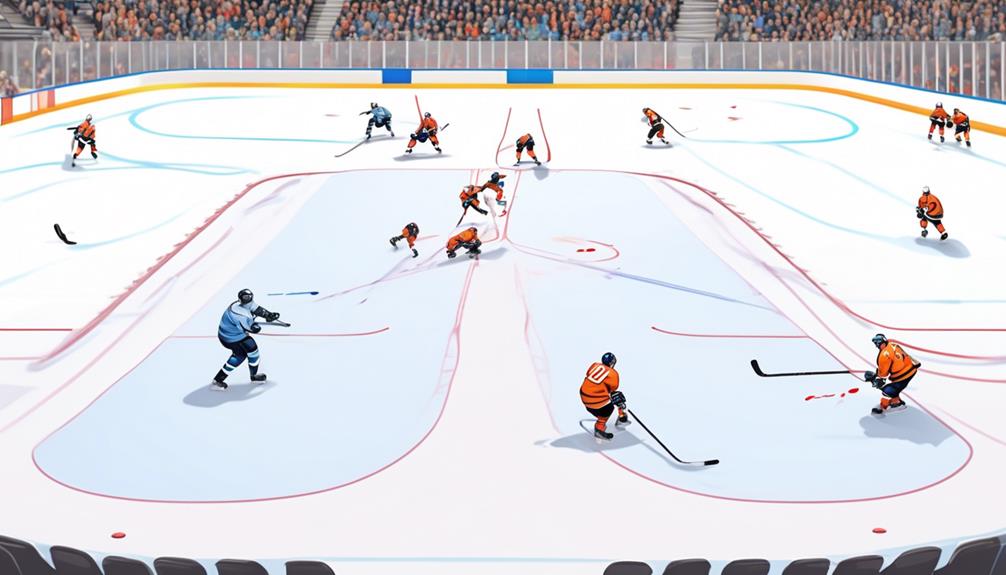Fresh Approaches to Hockey Neutral Zone Strategies
You may think that hockey neutral zone strategies are all about maintaining a defensive stance, but what if I told you there are fresh approaches that can completely shift the game?
By implementing aggressive forechecking tactics and utilizing speed and transition play, teams have been able to completely disrupt their opponents' neutral zone strategies.
These innovative methods have not only led to more effective offensive opportunities but have also forced turnovers and created scoring chances in the neutral zone.
Want to learn how these tactics could revolutionize your team's approach to the game?
Aggressive Forechecking Tactics
Aggressively forechecking the opponent's defensive zone can disrupt their breakout and create scoring opportunities for your team. By applying relentless offensive pressure on the opposing team's defensemen and forcing turnovers, you can capitalize on their mistakes and generate quality scoring chances. When executing aggressive forechecking tactics, it's crucial to maintain strong defensive positioning to prevent the opponent from capitalizing on counterattacks.
To effectively apply offensive pressure during forechecking, you need to anticipate the movements of the opposing team's defensemen. As they attempt to move the puck out of their zone, your aggressive forecheck should limit their time and space, forcing them into making rushed decisions. By doing so, you can create turnovers and regain possession of the puck in favorable positions, allowing for immediate scoring opportunities.
While maintaining offensive pressure, it's equally important to be mindful of your defensive positioning. As your team aggressively forechecks, the remaining players must position themselves strategically to cover potential passing lanes and provide support in case the opponent attempts a quick transition. Solid defensive positioning minimizes the risk of being caught off guard and helps sustain the pressure on the opposing team.
Trap Defense and Counterattacks
When implementing a trap defense, your team aims to clog the neutral zone, impeding the opponent's ability to enter your defensive zone with speed and control. This defensive strategy requires defensive zone discipline and structured defensive formations. It's about maintaining a tight defensive structure, forcing the opposition to either dump the puck in or make risky passes, which can lead to turnovers. The key to a successful trap defense lies in your team's ability to remain patient and work cohesively to limit the opponent's options.
While trap defense is focused on maintaining a strong defensive presence, it also provides the opportunity for opportunistic offensive rushes. As the opponent struggles to advance through the neutral zone, your team can capitalize on turnovers and create scoring chances. This is where offensive zone creativity comes into play. Players must be ready to transition quickly from defense to offense, utilizing their creativity and skill to capitalize on the counterattack.
It's important to strike a balance between defensive discipline and offensive opportunism when employing the trap defense. Players need to be mindful of their defensive responsibilities while also being ready to pounce on offensive opportunities. This requires a high level of awareness and communication among teammates.
Utilizing Speed and Transition Play
To effectively utilize speed and transition play, your team must focus on quick, coordinated movements to swiftly transition from defense to offense and capitalize on scoring opportunities. Speedy transitions are crucial in catching opponents off guard and creating offensive counterattacks. Quick puck movement and transition speed tactics are essential for maintaining momentum and pressuring the opposing team.
One effective strategy for utilizing speed and transition play is to emphasize quick puck movement through the neutral zone. By swiftly moving the puck and utilizing short, controlled passes, your team can maintain possession and quickly transition into the offensive zone. This quick and precise puck movement also allows for a rapid shift from defense to offense, catching opponents out of position and creating scoring opportunities.
Additionally, focusing on transition speed tactics can significantly impact your team's ability to capitalize on offensive counterattacks. By emphasizing speed and agility in transition play, your team can exploit gaps in the opposing team's defense and create high-quality scoring chances. Players with exceptional speed and acceleration can be strategically positioned to lead rapid counterattacks, putting pressure on the opposing team and creating scoring opportunities.
Incorporating these speed and transition play strategies into your team's overall game plan can lead to increased offensive productivity and the ability to capitalize on scoring opportunities. By emphasizing quick, coordinated movements and utilizing speedy transitions, your team can gain a competitive edge and maintain offensive pressure throughout the game.
Neutral Zone Overload Strategies
Implementing a neutral zone overload strategy can provide your team with a tactical advantage in disrupting the opponent's transition play and regaining possession of the puck. This strategy involves positioning more players in the neutral zone to apply defensive pressure and limit the opponent's ability to execute controlled breakouts. By overloading the neutral zone, your team can impede the opposing team's offensive progress and force turnovers, creating valuable scoring opportunities.
Defensive positioning is crucial in neutral zone overload strategies. Players must maintain proper spacing and coverage to effectively limit the opponent's passing options and force them into making hasty decisions. As the opponent attempts to advance the puck, your team's defensive support in the neutral zone can create turnovers and transition into offensive pressure.
To execute this strategy successfully, it's essential to maintain a balance between defensive stability and offensive pressure. While overloading the neutral zone with defensive-minded players, it's important to remain mindful of potential offensive opportunities. Your team should be prepared to quickly transition from a defensive stance to capitalize on turnovers and create scoring chances.
Implementing Reverse Flow Tactics

Consider adopting reverse flow tactics to disrupt your opponent's offensive rhythm and create counterattacking opportunities. By implementing these tactics, you can add a new dimension to your team's neutral zone play, keeping your opponents guessing and opening up avenues for quick transitions and offensive chances.
Here are some key points to keep in mind when incorporating reverse flow tactics:
- Unpredictability: Utilizing reverse flow tactics adds an element of surprise to your team's neutral zone creativity, making it more challenging for your opponents to anticipate your movements and defensive structure.
- Speed and Agility: Reverse flow execution requires swift and agile maneuvers to effectively disrupt your opponent's offensive rhythm. This can lead to turnovers and create scoring opportunities through rapid counterattacks.
- Strategic Positioning: Proper positioning is crucial when implementing reverse flow tactics. It involves intelligent placement of players to intercept and disrupt the opponent's offensive flow, leading to turnovers and quick transitions.
- Counterattacking Opportunities: By executing reverse flow tactics successfully, your team can capitalize on the disarray caused in the neutral zone, generating prime scoring chances through swift counterattacks.
Incorporating reverse flow tactics into your team's strategy can significantly impact the game's outcome by disrupting your opponent's offensive rhythm and creating opportunities for your team to capitalize on turnovers. By focusing on neutral zone creativity and honing reverse flow execution, your team can gain a competitive edge and elevate its overall performance on the ice.
Positional Pressure and Forcing Turnovers
Utilize strategic positional pressure to disrupt the opponent's offensive flow and force turnovers in the neutral zone. By applying aggressive positional pressure, you can exploit defensive gaps and create scoring opportunities.
When your team is on the defensive, positioning is crucial. By maintaining a tight defensive formation and recognizing defensive gaps, you can apply pressure to the opponent's puck carrier, increasing the chances of forcing a turnover in the neutral zone.
To effectively apply positional pressure, your team must work cohesively to limit the opponent's options and force them into making hasty decisions. This requires all players to be aware of their positioning and ready to support each other offensively and defensively.
When pressuring the opponent, it's essential to have a strong foundation of support from your teammates. This offensive support ensures that if the opponent manages to evade immediate pressure, there are additional teammates ready to continue the positional pressure and force turnovers.
Furthermore, the ability to anticipate the opponent's movements and exploit defensive gaps is essential in effectively pressuring the opposition. By identifying and capitalizing on defensive gaps, you can disrupt the opponent's offensive flow and create scoring opportunities for your team.
This strategic approach to positional pressure not only disrupts the opponent's rhythm but also increases the likelihood of regaining possession and transitioning to an offensive attack.
Tactical Dump and Chase Variations

To effectively execute tactical dump and chase variations, maintain a strong communication and understanding among your teammates to ensure seamless transitions and effective puck retrieval. When implementing these strategies, it's crucial to make split-second decisions and adapt to the ever-changing dynamics of the game.
Here are some variations to consider:
- Aggressive Forecheck: By utilizing an aggressive forecheck in the offensive zone, you can apply pressure on the opposing team, forcing turnovers and creating scoring opportunities. This approach requires quick and decisive actions to disrupt the opponent's defensive setup and gain puck control.
- Delayed Dump-ins: Implementing delayed dump-ins can catch the opposing team off guard, allowing your forwards to gain a strategic position for puck retrieval. This variation demands precise timing and coordination to execute effectively, increasing your chances of maintaining possession in the offensive zone.
- Cross-Corner Dumps: Utilizing cross-corner dumps can create confusion for the opposing defense, enabling your team to capitalize on loose pucks and maintain offensive pressure. This tactic requires calculated placement and intelligent positioning to maximize puck control and scoring opportunities.
- Chip and Chase: Incorporating a chip and chase approach can disrupt the opponent's defensive structure, giving your forwards the opportunity to utilize their speed and agility to regain possession in the offensive zone. This variation relies on smart puck placement and swift, coordinated movements to outmaneuver the opposing team and create scoring chances.
Neutral Zone Regroup and Possession Plays
When executing neutral zone regroup and possession plays, maintain fluid movement and strategic positioning to facilitate seamless transition from defense to offense. Regroup dynamics play a crucial role in setting up effective possession plays. As the puck is retrieved in the neutral zone, players must quickly adapt to create passing lanes and provide support for teammates. This requires constant awareness of positioning and movement to ensure a smooth transition. Players should focus on maintaining a structured formation that allows for quick and accurate passes to gain possession control.
Effective regroup dynamics involve the utilization of all available passing options, including utilizing the boards and utilizing the width of the ice. By spreading out and creating passing lanes, players can effectively regroup and maintain possession of the puck, thwarting the opposition's attempts to regain control. This strategic positioning sets the stage for controlled possession plays, enabling the team to enter the offensive zone with speed and precision.
Possession control is key to executing successful neutral zone regroup plays. Players must work cohesively to support the puck carrier and maintain possession, denying the opposition any opportunities to disrupt the play. This level of possession control requires quick decision-making and precise passing to keep the puck moving and create scoring opportunities. By mastering regroup dynamics and possession control, teams can effectively transition from defense to offense, gaining the upper hand in the neutral zone and setting the stage for offensive plays.
Frequently Asked Questions
How Can Teams Use the Neutral Zone to Create More Scoring Opportunities?
You can use the neutral zone to create more scoring opportunities by implementing effective neutral zone forecheck and transition game strategies. By disrupting the opponent's flow and quickly transitioning to offense, you can capitalize on scoring chances.
What Are Some Effective Ways for Teams to Disrupt Their Opponent's Neutral Zone Play?
You can disrupt your opponent's neutral zone play by using aggressive forechecking tactics and solid defensive positioning. Focus on quick transitions and effective puck management to limit their opportunities and create more chances for your team.
How Can Teams Maintain Possession and Control in the Neutral Zone?
To maintain possession and control in the neutral zone, focus on quick transitions and puck support. By swiftly moving the puck and providing strong support for the player with possession, you can effectively navigate through the neutral zone.
What Are Some Innovative Ways to Utilize the Neutral Zone to Create Offensive Pressure?
To create offensive pressure, utilize space in the neutral zone by implementing quick transitions. Stay proactive by identifying gaps and exploiting them to push the play forward, catching opponents off guard and creating scoring opportunities.
How Can Teams Effectively Defend Against Aggressive Neutral Zone Strategies?
To effectively defend against aggressive neutral zone strategies, focus on defensive positioning and tactical adjustments. Anticipate counter attacks and prioritize defensive transitions. Stay disciplined and communicate effectively to thwart the opponent's offensive pressure.
Conclusion
In conclusion, fresh approaches to hockey neutral zone strategies can have a significant impact on a team's performance. By implementing aggressive forechecking tactics, trap defense and counterattacks, utilizing speed and transition play, neutral zone overload strategies, reverse flow tactics, positional pressure and forcing turnovers, tactical dump and chase variations, and neutral zone regroup and possession plays, teams can gain a competitive edge on the ice.
It's important to continually evolve and adapt strategies to stay ahead in the game.
